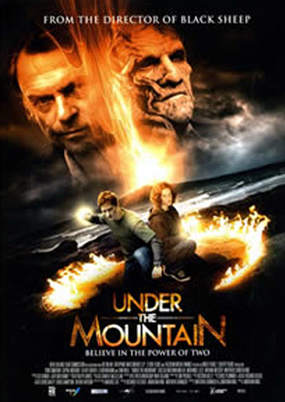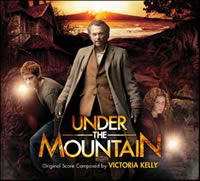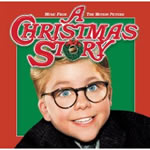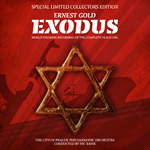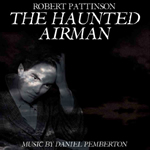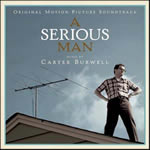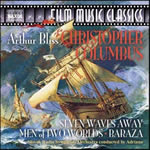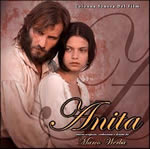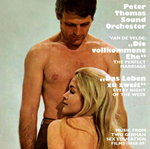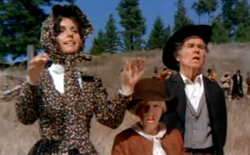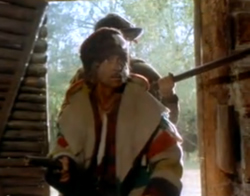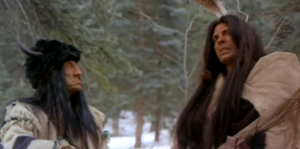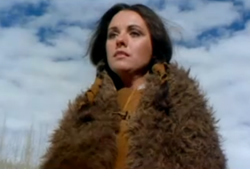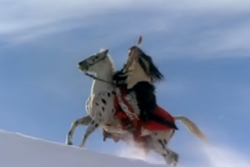
 |
Soundtrax: Episode 2009-15
December 21st, 2009By Randall D. Larson
Victoria Kelly Under the Mountain with Victoria Kelly
It was while I was watching a cool little horror comedy from New Zealand called Black Sheep, in which scientifically engineered sheep become blood-thirsty killers, that I was first taken with the music of Award-winning NZ composer Victoria Kelly. Her score was wonderfully exaggerated and the perfect accompaniment for the overblown but intelligently played out story. Her latest score, a powerful symphonic score for a rich fantasy film called Under The Mountain, was just released by MovieScore Media, offers continued evidence that this lady from the land of Kiwi is a composer worth reckoning with.
Q: What led you into writing music for films in New Zealand, and how did you break into the industry?
Victoria Kelly: I’ve written music for as long as I can remember and dreamed of being a film composer as soon as I realized what one was. I think I caught the film bug watching nature programs (it was the time-lapse photography and pulsing synths that did it) but I was discouraged at an impressionable age by meeting a film composer in Australia who spoke very negatively about the competitiveness and challenges of the job.
Still, I pursued music and later, when I was studying composition at university, I was approached by the secretary of the music school who had in turn been approached by a film student (Anna Reeves) needing someone to write original music for her first film - a 5 minute short called La Vie en Rose. The secretary recommended me and so I called Anna thinking ‘why not?’
It was during the recording session, when I saw the music with the pictures for the first time, that I got the definitive chill down my spine that told me beyond doubt that I’d found the thing I loved to do. I felt strongly enough about it to abandon my masters degree and throw myself on the mercy of our film industry (which in those days was very much smaller than it is now).
I get many communications from composers here in NZ who ask me how I broke into the industry and that’s the story I tell them. It isn’t very helpful considering it’s a story of serendipity and accidents, but it really is how I started and from there I just tried to follow opportunities where I found them, keep an open mind and work as hard as I could.
Q: What was most challenging for you in establishing a career as a film composer in NZ?
Victoria Kelly: I think it was the absence of money with which to not only produce an acceptable score on a single occasion, but with which to imagine that a sustainable career might be possible – either short or long term. That’s a challenge for any film composer, anywhere really – this work involves unique and sometimes precarious balances and there are no guarantees that one job will lead to another – but I think it has particular significance in a small industry like ours.
Q: What kind of experiences did you have on your first professional scoring assignments, and what did these initial opportunities teach you about writing music for film?
Victoria Kelly: My first short film was the epiphany that revealed what I wanted to do with my life. I did one more short film before I was offered my first feature, which was The Ugly, directed by Scott Reynolds. Working on a larger scale really taught me how little I knew about film scoring, despite all the enthusiasm in the world. That realization inspired me to do some further post-graduate study in the United States. When I look back, I can’t believe I managed to write a feature film score. I was flying by the seat of my pants with no idea of the correct way to go about negotiating the technical aspects of the work. I synched the entire film by pushing play and stop on a VHS recorder while I operated a metronome and played the piano at the same time. I wrote the whole score out by hand as I went. My way of showing demos to Scott was to play them on the piano alongside the VHS on a TV in the living room of my parent’s house. I don’t even think I had timecode in the pictures. In fact, I don’t think I even knew what timecode was!
Q: What kind of music did this psychological thriller require, and would you describe how you enhanced its mood, suspense, and effectiveness with your music?
Victoria Kelly: My memory of the learning curve on The Ugly almost outweighs my memory of the actual score and it’s years since I’ve seen or heard it. I was 23 at the time. It was a baptism by fire and there were many of us on the production who were taking that leap of faith for the first time. The crux of the music in The Ugly was that the audience needed to feel empathy with Simon, the central character, who is a serial killer tormented by apparitions that have arisen from his traumatic childhood. The music needed to be frightening but it also needed to create compassion for Simon’s character. In one scene in particular, Simon recalls a single moment of happiness from his life which is intercut with the brutal murder of the one person he loves. Scott wanted the audience to feel Simon’s horror and helplessness at his own actions as the violence took place, so the music had to evoke the tragedy of his circumstances without condoning his actions but also create tension around the murder. The job of the music throughout the film was to create that same balance on a larger scale as Simon’s story, along with the reality of his murders, is revealed. The score wasn’t big in terms of duration or orchestral forces - The Ugly had an extremely low budget but of course we wanted the music to sound bigger than it really was so there was a great deal of multi-tracking. The physical challenges and financial realities of the score certainly contributed to the way it evolved.
Q: You reconnected with Reynolds for the crime thriller Heaven. How did you determine the right music for this picture, and how closely did the director become involved in establishing the scope and placement of music?
Victoria Kelly: By the time we did Heaven, I’d been to USC and returned home feeling a little more technically confident. Scott’s films have a very distinct personality and visual style and he has unique ways of juxtaposing elements of a story using shifts in time that I think provide a powerful opportunity for music. In this film, a mystery was being revealed in unexpected ways and so the music had a very particular role to play in underlining the story.
By then, I’d spent a lot more time thinking about how music actually worked in a film and how to technically and formally approach a score, so rather than working entirely by instinct as I had on The Ugly, I was applying things I’d taken from my studies. Scott was completely involved in the process and had strong ideas about what he wanted the music to do.
When I think back to this time I realize how difficult it must have been for us to communicate, compared to how we might approach the same thing today. I was a late starter with technology so I didn’t have any music software. Scott had to imagine the music in its finished form, based on piano sketches I played for him live against video. To his credit, he was comfortable working this way and able to imagine things I could only describe with words and clumsy piano reductions. In terms of musical style - there are two things I think about in relation to these two scores. I was young and inexperienced at the time - and while there are obvious disadvantages to this, I was also less inhibited by what I thought film music should sound like, so I feel that I was able to develop ideas with a certain amount of freedom.
It was also a steep learning curve when it came to collaborating with another person and tailoring music to meet the needs of something other than my own personal taste or desire to compose. Scott wanted substantial input into the score which challenged me as I was coming to grips with this most crucial aspect of film composing. I had trained as a classical musician and composer until that point - with all the solitude and autonomy that one would expect from that career - so allowing someone else to influence my music was a profound shift.Q: By 2000 your filmography was showing a definite leaning toward horror films, with your score for The Irrefutable Truth About Demons. Do you find the musical opportunities inherent within this genre to be to your liking, and what kind of score did you provide for Glenn Standring’s Demons?
Victoria Kelly: That’s an interesting question because it’s quite by coincidence that my filmography has this leaning, although yes, I do like the musical opportunities presented by the horror genre.
There is a rich tradition of horror film making in New Zealand. There are cultural reasons for that I’m sure, but on a more practical level, horror is a niche genre with a well defined audience and as a result it is marketable and therefore frequently funded – an important consideration for people working on low budget productions and trying to find opportunities to begin their careers.So yes, I have written several horror scores and correspondingly, several scores for first time directors. It follows on that people in the NZ industry now associate me with this genre because it dominates my body of work. However, it is definitely the style of filmmaking rather than the genre itself that draws me in personally. I’m inspired by many different and often random aspects of the films I work on, but the things I take inspiration from have much less to do with the film’s genre than with the underlying aesthetic of the film and of course, the people I’m working with.
Demons was also a departure because I collaborated with a friend on the score – an electronic artist called Joost Langeveld. We’ve worked together on several projects but this was our first feature together. The score was beat-driven with orchestral elements and it occupied a very different musical world to the one I usually work in. I enjoyed experimenting and I loved working with Joost because it added all kinds of objectivity to the experience. That process also inspired me to step out of the stone age and get up to date on some music software. So now, though I’m still what I would call an acoustic composer, I sketch and demo on a computer and love the opportunities that technology offers music.
Q: I think one of the things music can be especially potent in doing is bringing to life fantastic environments and filling in the emotional gap that might not otherwise be threaded between audience and picture. In an expansive fantasy film like Riverworld or Maddigan’s Quest, how did you use music to support the drama while also enhancing the films’ sci-fi/fantasy environments?
Victoria Kelly: With a couple of exceptions, I think all my favorite film scores are science fiction/fantasy films. It’s the realization of an imaginary world and the opportunity to be transported to places where anything is possible that really attracts me to the Fantasy genre.
Maddigan’s Quest was a children’s TV series that I worked on with Simon Bennett, a producer I’d previously worked with in the theatre and who I’m working with again now. It was conceived by an iconic NZ children’s writer, Margaret Mahy, and an enormous amount of love and dedication went into the production. The series is set in a post-apocalyptic world, reassembled from the ruins of our own. It centers around a traveling group of performers, Maddigan’s Fantasia, who are on a mission to save their society’s source of power. They are joined by three mysterious children and pursued by two evil villains from an even more distant future.
It wasn’t a straightforward score at all. Each episode takes place in a different part of the world that the troupe voyages through, each community having its own culture and environment. The music needed to be completely different for every episode but still unified across the series. Usually in television, you’d be able to recycle a lot more material across the span of a series than it was possible to do for this one, so it was a big job.
The other consideration was that some of the music was played and sung on screen and this needed to be written in advance in order to be filmed using imaginary instruments all performed by the actors (I gave a few music lessons on that show). And of course it was all on a limited budget.
My idea for the music was to create an assembly of textures and styles that reflected the recycled culture of the world. There’s every kind of instrument, style and ethnicity represented somewhere in the score.Q: What kind of thematic structure does a film like this entail? Do you feel the use of leitmotifs works in scores like these, or do you avoid an overabundance of theme associations?
Victoria Kelly: I love a good theme association, but I try to use them in moderation. I also think that different films need different things and sometimes an abundance of themes isn’t called for. It all depends on the film.
Q: Your scores for Maddigan’s Quest and Fracture won the NZ Screen Awards in 2005 and 2007, respectively; and your Toy Love and Black Sheep scores were nominated for a NZ Film & TV Award in 2003 and 2008. How has this kind of recognition benefitted your career and opened the doors for further scoring assignments?
Victoria Kelly: New Zealand is a small country with a predominantly low-budget production schedule and we have the kind of industry where everyone knows each other personally, or knows of each other by reputation. It’s great to have awards here because it allows us to get together and be enthusiastic about what our industry has produced. I’m not sure if I’ve ever been offered work on the basis of having won an award, but being nominated for them has certainly made me feel like a valued member of the film industry and it’s certainly an honor to be recognized by your peers.
Q: Black Sheep was a neat mix of humor and horror, with a first-rate score that I felt really supported the threat of the evil ewes while not entirely taking its tongue out of its cheek. How did you derive the kind of music the film and its multiple nuances needed, and how did you work with director Jonathan King in developing the score and its placement throughout the film?
Victoria Kelly: Setting the tone of the film was definitely the fundamental business of this score and Jonathan and I exchanged a lot of ideas and listened to a lot of music together as we thought about exactly how far to go with it and what balance of comedy or horror to underline. As so often happens, all the ideas I formed when I was thinking about the film and reading the script went out the window when I saw it. Those crazy sheep were hilarious. In the end, I took my inspiration from Bernard Herrmann, whose scores for the Ray Harryhausen creature movies are beyond compare. You can hear how seriously he took his work, but also what a flight of fancy he went on. There was no irony in it... just enormous character. I wanted the score for Black Sheep to have character.
My approach in the end was to take everything at face value and just be literal. I had enormous fun on this score. The premise of the evil sheep was so funny that I didn’t want to overstate the comedy with music. They might be funny but their behavior is pretty antisocial, so I felt the job of the music was to follow the action and stay firmly in character.In terms of music placement and the way the score developed, I went through the usual process with Jonathan of spotting the film and then working through demos with him for each scene. He is a great collaborator because he has strong ideas but he’s also open minded and able to deliver feedback clearly, without eroding confidence. I have a great deal of respect for that kind of balanced, honest but circumspect approach and I think it allows real trust to flourish.
Once we decided how the score should feel and I had written a few cues and experimented with the language, it began to take shape. There were some scenes that were harder than the rest, mainly because the score is wall to wall and I think it’s hard to keep that much music under control, retaining the shape and tension when there’s so much suspense and jeopardy and absurdity. I found this aspect of the score a real challenge. That, and watching sheep biting faces off and pulling intestines out of innocent people over and over again...
Q: Robert Sarkies’ Out Of The Blue, on the other hand, was a thriller based on a true crime story in NZ. How did you approach scoring this film and its well-remembered true-life story and balancing the film’s focus between suspense/terror and heroic courage?
Victoria Kelly: Out of the Blue tells the story of a gun massacre that took place in a small South Island community in 1990. It was the sort of event that no one ever imagined could happen here and it had a profound effect on the entire country. Rob, the director, felt a deep sense of responsibility to the community at the centre of this event and he had a precise vision for the film. I think he captured the mood and landscape of the place and its culture perfectly.
Part of his vision was to avoid any kind of editorializing on the events, to observe the feelings of the survivors and to give the audience space for their own emotional responses. Originally there was no music at all in the film, although it does have beautiful sound design that creates a musical environment at crucial moments. Later though, Rob decided that he wanted music to begin and end the film.
The challenge in approaching this score was to find an inconspicuous language - something that would support the story without coloring or sentimentalizing it. It was difficult to achieve this of course - especially when the music enters at the end. To come from silence and integrate music into the film without drawing undue attention to it, or further pointing out its absence elsewhere, was a real challenge. There are only 9 minutes of score in the entire film. Rob was very closely involved as I wrote it.
Q: Your latest score was with Jonathan King again, in a vast fantasy Under The Mountain. Again you are facing a fantastical environment and a heroic fantasy storyline – what kind of opportunities did this film offer you? What elements of the story did you find to be central to your scoring approach, and how did you develop that throughout the score?
Victoria Kelly: Under the Mountain is an adaptation of a beloved New Zealand children’s book by Maurice Gee that was later made into a TV series that scared the living daylights out of my entire generation. The story centers on teenage twins who discover evil, shapeshifting creatures lurking beneath Auckland’s extinct volcanoes. The environment of the film is present day Auckland and so the element of the fantastical is revealed as the film progresses.
I grew up in Auckland and have lived here most of my life. I also read Under the Mountain about fifty times when I was a kid, so it is deeply ingrained in my memory and the landscape of the story is intimately familiar to me. The extinct volcanoes scattered throughout Auckland define its landscape, most particularly the central mountain of the story - an island called Rangitoto. So, in this score, the most dominant musical character became the mountain itself, along with what lies beneath it. The score is very dark in tone and register - I knew from the moment Jonathan asked me to do it that I wanted to present a place infused with invisible, subterranean danger. Apart from obvious thematic references to particular characters, the other central idea in the score is the twin-ness that bonds the protagonists, Rachel and Theo.
Jonathan loves music and, like Black Sheep, there is lots of it in this film. The wide palette of instruments and the scale of the sound also made a big difference to the way I wrote. I will happily admit that this score was a learning curve on the scale of my first feature because it was recorded all in one go with a full symphony orchestra, rather than recorded in layers on a smaller scale the way I’ve done things in the past.
Q: What are your plans for the future – and how are you finding opportunities in the growing and internationally-recognized New Zealand film industry? Where would you like to be in another 5-10 years?
Victoria Kelly: I have a pretty simple dream. I just want to be happy in my work. I want to work on films I believe in, with people I respect, and find the truest voice for the stories that are entrusted to me.
My thanks to Victoria for taking the time out of her schedule for this interview. Her music is amazing and provocative - for more information on Victoria Kelly and to hear samples of her music, have a visit to her web site at: www.victoriakelly.co.nz
New Soundtrax in Review
When they weren’t scoring terror films like Prom Night, Paul Zaza and Carl Zittrer has maintained an ongoing working relationship with director Bob Clarke, scoring his Sherlock Holmes/Jack the Ripper thriller, Murder by Decree and the high school locker room comedy, Porkys (Zittrer, solo, also scored Clarke’s slasher film Black Christmas, his earlier Children Shouldn’t Play With Dead Things, and Porky’s II). But the culmination of each of their creative art came with Clarke’s holiday masterpiece of 1983, A Christmas Story. Now available on a soundtrack album from Rhino Records, the double Z’s soundtrack is a wondrous affair. An exuberant and wide-ranging cartoon score, Zaza and Zittrer grasp music of every variety to concoct a delirious and delightful accompaniment for this truly iconic movie about growing up in small town 1940s Americana. Naturally there are a few samples of Christmas music used to set the mood, and two of the tracks have retained their sound effects, which in truth are part of the music that overplays the scene (the manic barn dance of “The Bumpus Hounds Make their Rounds” includes the necessary barks; while Ralphie’s Red Ryder day dream, “Black Bart Bites the Dust,” includes the horse whinnies, whiplashes, and gunshots among its rhythmic old west tunefulness and hoofbeats). There is a cute “antic” motif introduced in “A Meeting of the Minds” which recurs in several scenes with Ralphie and kind of becomes his theme; and uber-bully Scut Farkus and his “yellow eyes” have their own menace-rich motif; beyond this most cues are free standing compositions that enliven – either by playing with or playing against – the story’s sense of comedy and recognizable nostalgia – moments of musical pizzazz, holiday warmth, and even mob psychosis – such as the rolling snare drum and furtive chords of winds and tremolo violins in “Truth or (Triple Dog) Dare,” masterful accompaniment for one of the film’s funniest scenes – well, that and “The ‘F’ Word,” wherein funereal violins escorted by scythe-like swings of bassoon make an earth-shattering descent into darkness of everlasting shame, when Ralphie accidentally utters the wrong oath in his father’s presence. We also have the brilliantly campy “Ming the Merciless,” accompanying another of Ralphie’s pervasive daydreams – pure sci-fi melodrama. This is a thoroughly fun score worth its weight in Red Ryder BBs. Wonderful to have it in release 26 years after the movie came out.
One of the most memorable film themes of the last half century is Ernest Gold’s powerful, passionate theme from Otto Preminger’s 1960 historical drama about the founding of modern Israel, Exodus. Despite it’s being rendered into insignificance by hundreds of muzak orchestras in the lobbies and elevators of the world, Gold’s theme, as it is originally arranged and performed, is a masterwork of dramatic melody and musical development. But for the last forty-nine years all we have had is the same 13-track, 33:49 soundtrack album, favoring the more tuneful and less dramatic moments of the score, that was released in 1960. Finally, with Tadlow’s vivid reconstruction, we have the complete film score, powerfully conveyed by the masterful City of Prague Philharmonic, under the baton of Tadlow’s usual maestro, Nic Raine and preserved via high resolution 24-bit recording. Topping out at 25 tracks and some 80 minutes of score, Exodus becomes a revelation of impassioned perseverance. The large amount of the score that has hitherto gone unrecorded makes this recording brand new even for those quite familiar with the original 1960 sound track album. Gold’s main theme is developed with a myriad of new characteristics, interpreted across the cinematic canvas in a heartfelt progression of variations. “Kitty,” for example, is a marvelous piece for solo violin over piano that plays beneath a hotel scene involving the two main characters; an excellent example of Gold’s taking source music and transforming it into a recurring theme, the first portion of the violin melody becomes the love theme for the characters as their relationship later blossoms. It’s a lovely background melody, deceptively casual, but when it’s developed into something larger and longer lasting in “Love Is Where You Find It” it emphasizes a far more poignant interaction. Neither cue have appeared prior to this recording. Nor has “D-Day/The Bombs (Prison Break),” a tremendous action cue that really gets the orchestra going in a riot of musical conflagration. This is a masterful presentation of a magnificent score. Exodus is presented across one and a half discs; the balance of Disc 2 contains selections from other film scores the touch upon Israel or Jewish issues, including Goldsmith’s QB VII (culled from a previous Silva Screen compilation), Williams’ Schindler’s List, and Bernstein’s Cast A Giant Shadow; plus brief excerpts from two Ernest Gold scores for director Stanley Kramer – the exit music from It’s A Mad, Mad, Mad, Mad World, and a 5:11 cue from the wartime romance, Ship of Fools, and Sol Kaplan’s title cue from Daniel Mann’s 1966 drama, Judith. The album closes with two splendid concert pieces constructed from the Exodus score (one by Gold, one by Tadlow’s James Fitzpatrick), both of which very nicely revisit, extend, and resolve Gold’s major themes. The package includes thorough album notes, including appreciations from Marni Nixon (former Mrs. Ernest Gold), composer and former Gold student, Kathleen Mayne, and an excellent, comprehensive track-by-track commentary from Frank K. DeWald.
Jeremy Soule has provided an epic orchestral sounding game score for IL-2 Sturmovik: Birds of Prey, a new combat flight simulator game for PlayStation and Xbox. Soule has composed music for more than 60 games since 1995, and this latest work is rich in sampled symphonic flavors and the kind of sweeping, romantic melody lines and rhythms one would expect from a game of aerial conflict. With a primary theme that opens the album in full orchestral and choral splendor, Soule maintains a compelling musical approach that is full of impassioned flavors and engaging musical patterns. Aside from the introductory march overture, Soule’s “Chariots of Endearment” is a massively powerful and classically-based work that charges headlong out of the catapult and into the flak-dappled skies with an exhilarating energy; while “Valor and Triumph” resonates hugely with sampled orchestra and choral colors in a raging arc of victory; its antithesis, “Lament for a Pilot,” is a soft and sobering solo piano piece. Even if you’re not a gamer (I’m not), Soule’s score is a powerful and cinematically flavored composition that goes far beyond simple accompaniment for game play. The music evokes the code of honor of aerial battle over the skies of World War II Europe and expresses the feelings of being at the throttle of a skydiving fighter plane, under constant threat of attack, energizing the game experience and providing a masterful listening experience apart from it.
This and a number of Soule’s other gamescores are available at: www.directsong.com/index.php#/shop/set/1/4
For an interview with Jeremy, see: www.armchairempire.com/Interviews/jeremy_soule.htmThose unable to sufficiently advance in IL-2 Sturmovik may be fit for:
Daniel Pemberton’s score for The Haunted Airman, a 2006 film starring Robert (Twilight) Pattinson now getting new attention due to Pattinson’s involvement, accentuates the cerebral psychology of this film (based on a Dennis Wheatley story) about an wheelchair-bound, injured RAF pilot committed to an eerie hospital where he starts to lose his mind – haunted not by vengeful spirits but by the psychological disarray brought on by his post-traumatic stress, enhanced by the weird behavior of his doctor – with a quirky and fairly austere ensemble emphasizing a dark and unusual mix of treated pianos, child vocals, detuned violas, orchestral flourishes and custom sound design. The music circulates, its sound enhanced with reverb, closely around the wounded mind of Pattinson’s character, tied almost completely on his own perceptions. The score imposes its sonic character to accentuate his fear of spiders (atonal horror), unrequited romance (a disconsolate love theme), and his accelerating madness (shrieking, claustrophobic tremors of sustained high strings in “Something is Happening” to the hopeless resignation of a dour cello over piano in “Loss of Control”). Surrounding all of its dark timbres and atonal passages is a splendid, haunting main and end title melody featuring a child’s vocal over clockwork piano and xylophone, suggestive of the “inner child” at the center of the pilot’s refuge. It’s an interesting and discerning score, very effective in its close psychological interpretation; apart from the film, on cd, it’s at its best in its more melodic, accessible moments, but even in the midst of its disharmonic nuances, there is a tone poem, a kind of non-harmonic haiku, to be gleaned about the state of a character’s mind and how it perceives and has been affected by events old and new.
Carter Burwell’s score for the Coen Brothers’ new black comedy, A Serious Man, is out from Lakeshore. A trio of familiar 60s tunes from The Jefferson Airplane intermingle with Burwell’s score, which is indeed serious stuff, underplaying the comedy to lay down a thick carpet of brooding tonality onto the Coens’ bleak tale. It’s a short album, 33 minutes even with the Airplane tracks, but it’s what the film needed. Burwell’s short cues, mostly comprising reflective, ambient atmospheres and innocuous underlying tonalities, occasionally interrupted by stark, percussive sounds (as in the middle of “Good Riddance/The Canal,” whose heavy drums herald the way into a raucous rock rhythm; or the shocking thrum of a piano chord held in high reverb in “Rabbi Sting”). Gentle acoustic guitar picking, often supplemented by close-mic’d piano notes, provide an ongoing riffing beneath the Coens’ dark visual atmospheres. In many ways, A Serious Man is the same type of score Burwell has been writing for the Coens since Blood Simple, but he does in excellently and gives the film – and its music – an evocative sonic flavor which eloquently supports the kind of unease one finds in Joel and Ethan’s mesmerizing films. It works well on disc also, its bleak colors lending an intriguing sound pattern and a pleasing listen.
English classical composer Sir Arthur Bliss has been best known in film music circles for his first score, that to the 1936 science fiction classic, Things To Come. But the half dozen scores he wrote afterwards are equally of interest, and Naxos has provided three of them in their latest “Film Music Classics” release, splendidly performed by the Slovak Radio Orchestra, conducted by Adriano. The 1949 film, Christopher Columbus, in which Fredric March played the intrepid explorer, is molded around Spanish musical idioms, the composer’s attempt to evoke a touch of period and environment in a film populated by familiar English and American actors. A suite of ten tracks is provided, from the pervasive overture through a rendition of a number of subdued and very intricately worked out minor themes for characters and shipboard drama, to the splendid adventurism of the music associated with the sea voyage and the muscular musical conflict of “Mutiny” and “Columbus Put In Chains.” It’s a fine score, well worth discovering or rediscovering. 1956’s lost film, Seven Waves Away (aka US: Abandon Ship) , a drama about social conflicts on board a drifting lifeboat, ala Hitchcock’s Lifeboat, without the Nazi component, was given a powerful score that gave the microcosmic story much of its dramatic largess. Each of the three surviving cues is a musical showpiece, richly conveyed by the orchestra and marvelous to have to listen to. Men of Two Worlds, a 1945 film about an African composer/pianist struggling against dueling cultures in his native land and that of conservative Europe, particularly the conflict between the practices of his village witch doctor and the studied culture of the west. The score effectively interpolates African rhythms, if not ethnic instruments (the element primarily emphasized via a male chorus), to delineate the character and his challenges. Bliss later adapted the score into a concert piece for piano and orchestra with men’s voices, called “Baraza,” which is presented on a separate track in a vibrant rendition featuring the Slovak Philharmonic Male Choir. The music is quite stirring throughout, making the album a valuable addition to vintage film music and that of its composer.
Marco Werba’s music for the historical drama, Anita, has been released in a limited edition of 500 copies by Kronos Records of Germany. The film is a historical romance between 18-year old Anita and Italian revolutionary Giuseppe Garibaldi in 1939 Brazil, for which Werba has composed a sublime and poignant romantic score. The film’s director, Aurelio Grimaldi, is himself a composer who has scored films under the gender-confusing pseudonym of Maria Soldatini, and it had been his intention to score the film himself; but, as Werba describes in his composer’s note, budgetary reasons associated with Werba’s connection to a financier would have permitted a larger, fully orchestral score to be provided. Thus Werba came onto the film, supplying his own beautifully conceived music while also arranging some of the material Grimaldi had composed – four of the cues include this collaboration. A couple cues incorporate period-friendly elements of Beethoven, but the sweetener is always Werba’s passionate main theme, which undergoes a number of varied perspectives as the score develops. By centering the music around Anita’s theme, Werba keeps the young lady at the story’s focus even as the powerful presence of Garibaldi and other world events occur at her perimeter; the music beautifully captures the blossoming of young love.
German composer Peter Thomas is having something of a revival in recent months, aided in part by a revival of interest in lounge music and in 1960s European exploitation film music. At least three digital compilations of his multitude of scores for these films have made their way through iTunes in recent months, with an equal amount of separate CD issues. Thomas’ tuneful pop/jazz/lounge approach to film music, while perhaps lacking in a dramatic edge, nonetheless provided unique and effective accompaniment for German terror films like The Hunchback of Soho and a whole slew of Edgar Wallace thrillers, not to mention the pop tunesmithing for TV’s Space Patrol. Thomas also wrote music for sexploitation films – what has been called German sex education-movies, which boomed in the late 1960s, although clearly the emphasis was much more on the sex than on the education – a variety of cinema especially adept to his kind of easy/lounge pop which, apart from their visuals, remains as very catchy and pleasing as music irrespective of its visual inspiration. Allscore Media, in cooperation with Chris’ Soundtrack Corner, has released two of Thomas’ scores for these films on a new CD. Die Volkommene Ehe (The Perfect Marriage) and Das Leben Zu Zweit (Every Night of the Week) were both adapted from a 40 year old book by the Dutch gynecologist Theodoor Hendrik van de Velde by director Franz Josef Gottlieb to create these two (pseudo-) scientific movies. The music is what Thomas does best – catchy modern jazz and pop rhythms. The first film is scored with a delirious romantic intensity; the second with a contemporary jazz/beat style, with touches of Herb Alpert trumpets, late 60’s pop organ and piano, lush harps, crystal clear electric guitars and chorus, and quirky, teasingly sung female voicings are spread across the instrumental mix. The music is cool and entertaining and a lot of fun. There are a few recurring rhythmic motifs but for the most part each cue is its own piece, so to speak. The album closes with a pop organ rendition of “Here Comes The Bride.” Film cues are jumbled across the single disc compilation, although they are identified by film – although I suspect track 8 (“Natascha – Main Theme”), which is listed as from The Perfect Marriage, is really from Every Night of the Week since it’s the same tune as track 1 (Every Night’s “Natascha – End Title”) and is in keeping with the pop vibe of that score. Informative liner notes, presented in both German and English, provide excellent background data on the films and the genre of “sex-education” cinema in Germany. Thomas was brilliant in doling out these marvelous bits of 60’s Europop, and it didn’t seem to matter if the subject was sex, horror, or mystery – his approach was the same, and it fit the style of these kinds of films perfectly. This new release is a winning collection of that music.
http://www.allscore.de/sites/ASM_029.htm
Lee Holdridge’s Music for Winterhawk
A Track-by-Track AnalysisWhen I was asked to write the notes for the soundtrack album of Lee Holdridge’s music for Winterhawk, shipping this week by my hosts here at BSX Records, I was so enthusiastic about the score that I included an overview of the film and its score plus an analysis of each track on the album. Since the score was removed from the film for its home video release [see below], I felt the added analysis would be beneficial. But the notes turned out to be too long for the booklet! The track-by-track commentary had to be snipped out of the release, but I am pleased to include them here as a bonus supplement for those who bought the soundtrack album (and if you didn’t, I recommend it heartily – my notes or not – as an outstanding orchestral score from a great composer).
Winterhawk, directed in 1975 by Charles B. Pierce, tells of the young chief of a tribe of Blackfoot Indians in northern Montana whose desperate search for medicine to cure his people from the ravages of smallpox leads to his desperate encounter with white fur traders, ruthless outlaws, and a young missionary’s niece whose trust will change both of their lives. The musical score was composed by Lee Holdridge, with assistance from Nicolas Flagello and William Goldstein due to a very tight deadline.
Incidentally, when the movie was released on VHS in 2001 by Good Times Video, the company removed Holdridge’s entire score, for obscure licensing reasons, and replaced it with a cheap synth-based score for the home video release that didn’t cost them as much. The film loses a tremendous amount of its glory and honor with the loss of Lee’s score, and has not yet been subsequently released on home video. However, as of this writing, Winterhawk can be viewed online with the masterful Holdridge score intact, at: www.hulu.com/watch/92768/winterhawk - rdl.
The Story and Music of WINTERHAWK
Track 1: Main Title / Montana / Winterhawk: When his young son dies from smallpox, Winterhawk rides out to a rendezvous camp where fur traders, mountain men, and missionaries have gathered. He intends to trade furs for medicine to cure his village. The Main Titles appear over his journey on horseback to the trading camp. Throughout the film, Holdridge uses this theme to represent the land and the people – the big sky country in which the proud Blackfoot nation seeks to endure. The secondary theme appears as the film’s title appears on screen – based around an adventurous and noble 3-note melody intoned wordlessly by chorus, which in its later sung version easily accommodates the 3-syllable vocal line, “Winterhawk!”
Track 2: The Story Begins: This brassy fanfare commences during a sweeping pan across the fur rendezvous grounds, showing various activities and introducing most of the secondary characters, including narrator Clayanna (Dawn Wells) and her uncle Will Finley (Elisha Cook. Jr.), brother Cotton (Chuck Pierce Jr.), Arkansas (Denver Pyle), Big Rude (Woody Strode), and Little Smith (Jimmy Clem). The scene cuts to Winterhawk and his four braves coming out of the forest on horseback causing no little consternation and interest amount the trading folk.
Track 3: Winterhawk Theme: When Winterhawk informs the traders he needs medicine for smallpox, the mountain men and missionaries alike all back away. One of the traders who speaks his language, Gates (L.Q. Jones), tells Winterhawk that he will lead him to a man who may be able to help, but in fact Gates and his subordinate buddy Scoby (Dennis Fimple) instead wait in ambush, killing the three braves and stealing Winterhawk’s precious furs. A furtive, suspenseful motif resonates in the string section, erupting when the shooting begins; as Winterhawk escapes, galloping away on his spotted horse, the music resonates with pride for the deceived chief, his theme sounding with a firm rhythmic resolve.
Track 4: Little Smith Theme. This jaunty folk dance melody, composed for Holdridge by William Goldstein, is heard when we first meet the happy if smelly mountain man, dancing with a fat girl at the trading post. When another man tries to cut in, Little Smith knocks him out and resumes dancing, his fiddle tune capturing his cheer and free spirit. After Winterhawk has returned to the trading camp and captured Clayanna and Cotton in retaliation for his betrayal by the white outlaw, this version if heard when Little Smith and the other mountain men, in pursuit of Winterhawk and his captives, cross a ridge, and are confronted by a large number of Blackfoot braves. Little Smith fails to notice his comrades have all backed off, and charges headlong down the hill toward the Indians. Once he realizes he is on his own, he tries in vain to stop his horse, which balks and dumps him on the ground. His theme sounds comically as he retrieves his fallen rifle and runs on foot back up the hill.
Track 5: A New Day: The mountain men trying to catch up with Winterhawk in order to retrieve Finley’s captured niece and nephew friend recruit Elkhorn Guthrie (Leif Erickson), Winterhawk’s friend and the husband of an Indian squaw, to lead them to the Blackfoot camp. The music sounds serenely as we pan across the gorgeous forests and meadows, teeming with wildlife. Winterhawk’s theme returns as we cut to the heavy beats of Indian horses galloping along on their way to the distant Blackfoot village.
Track 6: Beautiful Land: Winterhawk detects the white man’s scent on the wind, and becomes aware he is being followed. Clayanna tells him their uncle can pay well for their return. Winterhawk replies that he took them not for ransom but because the white man stole from him. The music continues for further riding scenes through the forest.
Track 7: The Killers: Holdridge launches an assault of aggressive music as Gates and Scoby take advantage of Guthrie’s absence to bust in on his cabin and attack his Indian wife, Pale Flower (Sacheen Littlefeather), and steal her horse.
Track 8: The Violation: The following day, the outlaws leave the cabin, Gates having raped & killed Pale Flower during the night. At 0:27 we move into propulsive music for the mountain men as they continue to follow the Indians, heading toward the mountains.
Track 9: Little Smith and the Gang: Winterhawk sends three braves back to stop Guthrie from following them, even if it means his friend must be killed. The music begins as we cut to the mountain men, standing their ground as the Indians approach on horseback, arrows flying. Firing in defense, the mountain men kill two of the braves and one of their own is shot with an arrow, while the third Indian escapes.Track 10: The Trek: The third brave rejoins Winterhawk as the Indians cross a river, and tells his chief what happened before he collapses into the water.
Track 11: Night Talk: Clayanna slides off her horse and helps the wounded brave out of the water. As two of the Indians lift him onto a horse, Winterhawk regards her with curiosity; he then cuts off her wrist ties and those of Cotton, and all proceed ahead towards the Blackfoot land. The music ends as the band reaches the mountain camp at dusk, and Clayanna insists on having a talk with Winterhawk, explaining again that he will be rewarded if he lets them go. Saying nothing, the Blackfoot chief turns his back.
Track 12: A Bath for Little Smith: Guthrie, Arkansas, and Rude have had enough of Little Smith’s stink, and throw him in the river for a very necessary bath. The music begins after his dunking as he gets out of water, the others laughing heartily. The Little Smith theme sounds jauntily as he stomps off; but the music sours as he confronts some Indians and shoots them, but is in turn shot by several arrows, resulting in:
Track 13: Little Smith’s Death: A lone trumpet sounds as Little Smith succumbs to his arrow wounds and collapses into the river. The cue resolves quietly as the others gather around as Little Smith is buried by the river.
Track 14: The Quest: The first 35 seconds of this cue is not used in the film. As we cut from end of burial to the group continuing on after Winterhawk, the rhythmic woodwind and strings motif propelling them up into the mountains.
Track 15: Whispered Voices on the Winds / The Hunt (or: Meditations / The Hunt): This pattern of mystical strings and soft choir intone eerily as Winterhawk gazes out over the high mountain plains, seeking wisdom from the winds that blow across the high mountain plains. At 1:17 we shift into “The Hunt” as the Indian band proceeds higher and higher into the cold mountains, aware their pursuers drive on behind them.
Track 16: A Thoughtful Interlude: The track covers a number of brief, consecutive sequences. Guthrie and the band show up at McClusky’s and learn he has been sold the stolen furs. McClusky recognized Pale Flower’s horse as one of Gates’ pack ponies. Low flutes intone dolefully as McClusky (Arthur Hunnicutt) describes the men, and Guthrie realizes what they must have done to Pale Flower to have stolen her pony. He asks McClusky, “Which way?” as the music turns grim. The music assumes a pensive rhythm, punctuated by sharp piano notes as they head off after Gates and Scoby. At 1:33 music opens into a bit of action material – this was not used in film, which instead reprised a segment of the main theme as we cut to several shots of the mountain men making their way higher into the snowy mountains. At 1:58 we segue to brassy action music as Guthrie catches up to the outlaws, and shoots Gates in the face. As Scoby begs for his life, the music fades out at 2:17. Guthrie brings Scoby back to the mountain men, captive. We then cut to Winterhawk and his band heading through high mountain snows. At 2:38, soft figures of winds sound quietly beneath dialog as Cotton asks Winterhawk if he has a woman. She died, the chieftain tells him, along with their son, many seasons ago from small pox.
Track 17: Old Friends: Cotton joins Clayanna as she is setting up their furs for their bedding. He informs her that Winterhawk is unmarried, much to her embarrassment, although she grins when she turns away from the boy. As they talk some more, the soft woodwind music from track 16 continues, and she notices Winterhawk regarding her again with interest. Then the music goes into a refrain of Amazing Grace (the same hymn Clayanna was leading at the trading post when Winterhawk first appeared) as she and Cotton say evening prayers.
Track 18: Confrontation: The Indian band arrives at the mountain camp, where Winterhawk speaks to his father, the elderly Red Calf (Western artist Ace Powell in his only film role). Winterhawk tells the old man that he intends to trade the white woman and boy for the medicine his tribe needs. Soft woodwind music paints the landscape as we pan to a serene, mountain creek, where Big Rude, having snuck into the village on his own, captures Red Calf and confronts Winterhawk, demanding he exchange the girl and boy for the old man. But the weak and aged Red Calf instead dies of a heart attack in his arms. The aggressive music bespeaks Rude’s loss of advantage as Winterhawk approaches, menacingly. The music dissolves as we cut to Guthrie and the other mountain men, hearing Rude’s scream echoing across the distance.
Track 19: Icy Landscape: The first 51 seconds of this cue were intended for the scene where Arkansas uses a long rifle to shoot Rude and put him out of his misery when Winterhawk threatens to torture him if the mountain men don’t leave. The film instead used a reprise of the Main Theme in its place, giving the grim scene a rather awkward sonority. At 0:52, a fragile flute figure accentuated by bell tree sounds gently as Winterhawk regards his namesake – a flying hawk, as it takes down a hapless duck in midair, the kill accompanied by a descending glissando of resolute violins. It is the next day. At 1:40, a soft, fateful cadence in the strings begins, as Guthrie also observed the hunting hawk, and understands it as an omen of their own fate. The others wake from a fitful slumber to notice a band of Blackfoot waiting for them just beyond their camp, as a fatalistic throbbing of drums overpowers the violin rhythm.
Track 20: Snow Pursuit: Somber strains of violin doubles by low piano chords etch a grim picture as the two forces confront one another on the snow. Finley notices with relief that Cotton and Clayanna are also there, and appear well. A cluster of brass figures at 0:15 circulate around Cotton as he tries to ride his horse toward them, but the Indians rush out and stop him. Guthrie rides out and delivers Scoby, and the body of Gates, the man who cheated him, to Winterhawk; but the Indian chief insists only on trading the white woman and boy for medicine. “I ain’t leavin’ without ‘em!” Guthrie says. “Then we fight,” Winterhawk answers his friend, dolefully, his statement underlines by several downward bursts of trumpets. The two face off on horseback with Indian spears as the music revolves with aggressive, anxious, and pensive movements. Cotton rushes out to stop the fight just as Guthrie hurls his spear, and is impaled in the leg.
Track 21: Farewells: A soft flute melody over harp commences as Winterhawk and Guthrie, their fight forgotten, rush to aid Cotton, announcing over Clayanna’s shrill screams that he is only wounded. The scene cuts to a while later as Cotton, bandaged and laid on a furred stretcher, says farewell to Winterhawk, who gives him one of his leather necklaces.
Track 22: Finale: Winterhawk refuses to honor Scoby with death. Guthrie has the cowardly outlaw remove his coat, and they leave him behind. The Main Theme sounds gently from flutes over strings as they depart, Clayanna lingering a while, until Winterhawk moves off to join his braves. Holdridge’s choir intones softly with the theme, as she joins the others and all head their separate ways, leaving Scoby to face the elements on his own. The camera lingers on Clayanna as she rides on, indecision troubling her as the music swells, yearningly; finally she makes her decision and leaves the mountain men, riding off to join Winterhawk and make her future among the Blackfoot.
Track 23: Winterhawk: This is the vocal rendition of the Winterhawk Theme, heard initially in between tracks 4 and 5 when Winterhawk kidnaps Clayanna and Cotton from the trading post. It is reprised here over then End Titles. The lyrics are by screenwriter Earl E. Smith.
© 2009 Randall D. Larson. The first half of the Winterhawk notes can be found on the soundtrack CD, now shipping from BSX Records.
Randall Larson was for many years senior editor for Soundtrack Magazine, publisher of CinemaScore: The Film Music Journal, and a film music columnist for Cinefantastique magazine. A specialist on horror film music, he is the author of Musique Fantastique: A Survey of Film Music from the Fantastic Cinema and Music From the House of Hammer. He now reviews soundtracks for Music from the Movies, Cemetery Dance magazine, and writes for Film Music Magazine and others. For more information, see: www.myspace.com/larsonrdl
Randall can be contacted at soundtraxrdl@aol.com

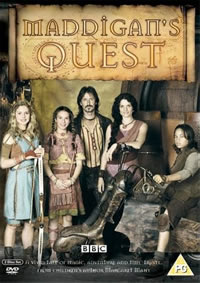
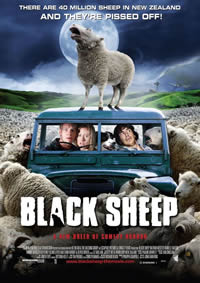
.jpg)
